Multidisciplinary rehabilitation for older people with hip fractures
- PMID: 34766330
- PMCID: PMC8586844
- DOI: 10.1002/14651858.CD007125.pub3
Multidisciplinary rehabilitation for older people with hip fractures
Abstract
Background: Hip fracture is a major cause of morbidity and mortality in older people, and its impact on society is substantial. After surgery, people require rehabilitation to help them recover. Multidisciplinary rehabilitation is where rehabilitation is delivered by a multidisciplinary team, supervised by a geriatrician, rehabilitation physician or other appropriate physician. This is an update of a Cochrane Review first published in 2009.
Objectives: To assess the effects of multidisciplinary rehabilitation, in either inpatient or ambulatory care settings, for older people with hip fracture.
Search methods: We searched the Cochrane Bone, Joint and Muscle Trauma Group Specialised Register, CENTRAL, MEDLINE and Embase (October 2020), and two trials registers (November 2019).
Selection criteria: We included randomised and quasi-randomised trials of post-surgical care using multidisciplinary rehabilitation of older people (aged 65 years or over) with hip fracture. The primary outcome - 'poor outcome' - was a composite of mortality and decline in residential status at long-term (generally one year) follow-up. The other 'critical' outcomes were health-related quality of life, mortality, dependency in activities of daily living, mobility, and related pain.
Data collection and analysis: Pairs of review authors independently performed study selection, assessed risk of bias and extracted data. We pooled data where appropriate and used GRADE for assessing the certainty of evidence for each outcome.
Main results: The 28 included trials involved 5351 older (mean ages ranged from 76.5 to 87 years), usually female, participants who had undergone hip fracture surgery. There was substantial clinical heterogeneity in the trial interventions and populations. Most trials had unclear or high risk of bias for one or more items, such as blinding-related performance and detection biases. We summarise the findings for three comparisons below. Inpatient rehabilitation: multidisciplinary rehabilitation versus 'usual care' Multidisciplinary rehabilitation was provided primarily in an inpatient setting in 20 trials. Multidisciplinary rehabilitation probably results in fewer cases of 'poor outcome' (death or deterioration in residential status, generally requiring institutional care) at 6 to 12 months' follow-up (risk ratio (RR) 0.88, 95% confidence interval (CI) 0.80 to 0.98; 13 studies, 3036 participants; moderate-certainty evidence). Based on an illustrative risk of 347 people with hip fracture with poor outcome in 1000 people followed up between 6 and 12 months, this equates to 41 (95% CI 7 to 69) fewer people with poor outcome after multidisciplinary rehabilitation. Expressed in terms of numbers needed to treat for an additional harmful outcome (NNTH), 25 patients (95% CI 15 to 100) would need to be treated to avoid one 'poor outcome'. Subgroup analysis by type of multidisciplinary rehabilitation intervention showed no evidence of subgroup differences. Multidisciplinary rehabilitation may result in fewer deaths in hospital but the confidence interval does not exclude a small increase in the number of deaths (RR 0.77, 95% CI 0.58 to 1.04; 11 studies, 2455 participants; low-certainty evidence). A similar finding applies at 4 to 12 months' follow-up (RR 0.91, 95% CI 0.80 to 1.05; 18 studies, 3973 participants; low-certainty evidence). Multidisciplinary rehabilitation may result in fewer people with poorer mobility at 6 to 12 months' follow-up (RR 0.83, 95% CI 0.71 to 0.98; 5 studies, 1085 participants; low-certainty evidence). Due to very low-certainty evidence, we have little confidence in the findings for marginally better quality of life after multidisciplinary rehabilitation (1 study). The same applies to the mixed findings of some or no difference from multidisciplinary rehabilitation on dependence in activities of daily living at 1 to 4 months' follow-up (measured in various ways by 11 studies), or at 6 to 12 months' follow-up (13 studies). Long-term hip-related pain was not reported. Ambulatory setting: supported discharge and multidisciplinary home rehabilitation versus 'usual care' Three trials tested this comparison in 377 people mainly living at home. Due to very low-certainty evidence, we have very little confidence in the findings of little to no between-group difference in poor outcome (death or move to a higher level of care or inability to walk) at one year (3 studies); quality of life at one year (1 study); in mortality at 4 or 12 months (2 studies); in independence in personal activities of daily living (1 study); in moving permanently to a higher level of care (2 studies) or being unable to walk (2 studies). Long-term hip-related pain was not reported. One trial tested this comparison in 240 nursing home residents. There is low-certainty evidence that there may be no or minimal between-group differences at 12 months in 'poor outcome' defined as dead or unable to walk; or in mortality at 4 months or 12 months. Due to very low-certainty evidence, we have very little confidence in the findings of no between-group differences in dependency at 4 weeks or at 12 months, or in quality of life, inability to walk or pain at 12 months.
Authors' conclusions: In a hospital inpatient setting, there is moderate-certainty evidence that rehabilitation after hip fracture surgery, when delivered by a multidisciplinary team and supervised by an appropriate medical specialist, results in fewer cases of 'poor outcome' (death or deterioration in residential status). There is low-certainty evidence that multidisciplinary rehabilitation may result in fewer deaths in hospital and at 4 to 12 months; however, it may also result in slightly more. There is low-certainty evidence that multidisciplinary rehabilitation may reduce the numbers of people with poorer mobility at 12 months. No conclusions can be drawn on other outcomes, for which the evidence is of very low certainty. The generally very low-certainty evidence available for supported discharge and multidisciplinary home rehabilitation means that we are very uncertain whether the findings of little or no difference for all outcomes between the intervention and usual care is true. Given the prevalent clinical emphasis on early discharge, we suggest that research is best orientated towards early supported discharge and identifying the components of multidisciplinary inpatient rehabilitation to optimise patient recovery within hospital and the components of multidisciplinary rehabilitation, including social care, subsequent to hospital discharge.
Trial registration: ClinicalTrials.gov NCT01254942 NCT03906864 NCT00667914 NCT01052636 NCT01350557 NCT01051830 NCT01009268 NCT00000436 NCT03301584 NCT01435538 NCT00951691 NCT00962910.
Copyright © 2021 The Cochrane Collaboration. Published by John Wiley & Sons, Ltd.
Conflict of interest statement
None of the authors have a conflict of interest. As Ian Cameron was an investigator in three of the included trials, these trials were assessed independently by other review authors.
Figures


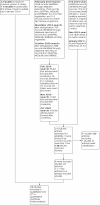

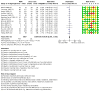

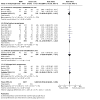
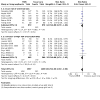


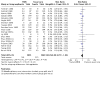
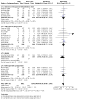





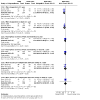
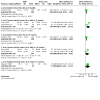



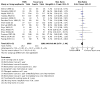

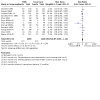
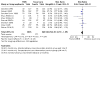


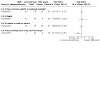
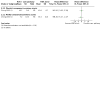

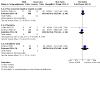
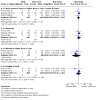

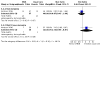


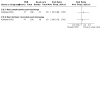
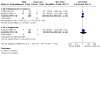


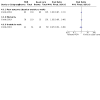
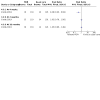


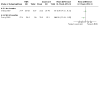


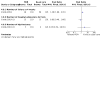
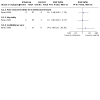

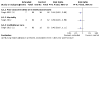


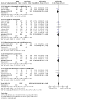

Update of
-
Multidisciplinary rehabilitation for older people with hip fractures.Cochrane Database Syst Rev. 2009 Oct 7;(4):CD007125. doi: 10.1002/14651858.CD007125.pub2. Cochrane Database Syst Rev. 2009. Update in: Cochrane Database Syst Rev. 2021 Nov 12;11:CD007125. doi: 10.1002/14651858.CD007125.pub3. PMID: 19821396 Updated.
Comment in
-
Is multidisciplinary rehabilitation effective for individuals with hip fractures? - A Cochrane Review summary with commentary.J Musculoskelet Neuronal Interact. 2023 Mar 1;23(1):1-3. J Musculoskelet Neuronal Interact. 2023. PMID: 36856095 Free PMC article. No abstract available.
References
References to studies included in this review
Ashe 2019 {published data only}
-
- Ashe M. Personal communication (plans for main report; clarification on numbers recruited; no deaths; reason for change in inclusion criterion regarding timing) 2 January 2020.
-
- NCT01254942. Mobilizing evidence into action to improve outcomes of vulnerable seniors. clinicaltrials.gov/ct2/show/ (first received 7 December 2010).
-
- Zusman EZ, Dawes M, Fleig L, McAllister MM, Cook WL, Guy P, et al. Older adults' sedentary behavior and physical activity after hip fracture: results from an outpatient rehabilitation randomized controlled trial. Journal of Geriatric Physical Therapy 2019;42(2):E32-8. [DOI: 10.1519/JPT.0000000000000193] - PubMed
Baroni 2019 {published data only}
-
- Baroni M, Serra R, Boccardi V, Ercolani S, Zengarini E, Casucci P, et al. The orthogeriatric comanagement improves clinical outcomes of hip fracture in older adults. Osteoporosis International 2019;30(4):907-16. - PubMed
-
- Ruggiero C. Personal communication (notice of publication of trial report) 16 May 2019.
-
- Ruggiero C. Personal communication (status of trial) 17 March 2016.
-
- Serra R, Prenni V, Baroni M, Loiacono C, Radicchi R, Gaggi L, et al. The orthogeriatric comanagement improves clinical outcomes compared with consultant geriatric service and traditional model (abstract). European Geriatric Medicine 2013;4:S49.
Cameron 1993 {published and unpublished data}
-
- Cameron I, Lyle D, Quine S. Accelerated rehabilitation after proximal femoral fracture: a randomised controlled trial. Proceedings of the Annual Conference of the Australian Association of Gerontology 1991;26:87-90.
-
- Cameron ID, Lyle DM, Quine S. Accelerated rehabilitation after proximal femoral fracture: a randomized controlled trial. Disability and Rehabilitation 1993;15(1):29-34. [PMID: ] - PubMed
-
- Cameron ID, Lyle DM, Quine S. Cost effectiveness of accelerated rehabilitation after proximal femoral fracture. Journal of Clinical Epidemiology 1994;47(11):1307-13. [PMID: ] - PubMed
-
- Quine S, Helby L, Cameron I, Lyle D. Carer burden after proximal femoral fracture. Disability and Rehabilitation 1994;16(4):191-7. [PMID: ] - PubMed
Chong 2013 {published data only}
-
- Chong TW, Chan G, Feng L, Goh S, Hew A, Ng TP, et al. Integrated care pathway for hip fractures in a subacute rehabilitation setting. Annals of the Academy of Medicine, Singapore 2013;42(11):579-84. - PubMed
-
- NCT03906864. Care pathway for sub-acute hip rehabilitation. clinicaltrials.gov/ct2/show/NCT03906864 (first received 8 April 2019).
Crotty 2003 {published and unpublished data}
-
- Crotty M, Finucane P, Hayball N, Gray S, Krishnan J, Wells V, et al. A trial of rehabilitation in the home (RITHOM) for patients with fractured neck of femur: an early report [abstract]. Australian & New Zealand Journal of Medicine 2000;30(2):295.
-
- Crotty M, Gray S, Whitehead CH, Gray S. Early discharge and home rehabilitation after hip fracture achieves functional improvements: a randomized controlled trial. Clinical Rehabilitation 2002;16(4):406-13. - PubMed
-
- Crotty M, Kittel A, Hayball N. Home rehabilitation for older adults with fractured hips: how many will take part? Journal of Quality in Clinical Practice 2000;20(2-3):65-8. - PubMed
-
- Crotty M, Whitehead C, Gray S, Finucane P, Hayball N. Rehabilitation in the home (RITHOM) for patients with fractured neck of femur: preliminary results [abstract]. Internal Medicine Journal 2002;32 (Suppl):A38.
-
- Crotty M, Whitehead C, Miller M, Cray S. Patient and caregiver outcomes 12 months after home-based therapy for hip fracture: a randomized, controlled trial. Archives of Physical Medicine and Rehabilitation 2003;84:1237-9. [MEDLINE: ] - PubMed
Crotty 2019 {unpublished data only}
-
- ACTRN12612000112864. SACRED - Southern Adelaide co-ordinated regional hip and debility rehabilitation programme to improve quality of life. www.anzctr.org.au/ACTRN12612000112864.aspx (first received 19 January 2012).
-
- Crotty M, Killington M, Liu E, Cameron ID, Kurrle S, Kaambwa B, et al. Should we provide outreach rehabilitation to very old people living in nursing care facilities after a hip fracture? A randomised controlled trial. Age and Ageing 2019;48(3):373-80. [DOI: 10.1093/ageing/afz00] - DOI - PMC - PubMed
-
- Crotty M. Personal communication. Email providing further data including mortality at 4 months and non ambulators at 12 months 30 September 2017.
-
- Killington M, Walker R, Crotty M. The chaotic journey: recovering from hip fracture in a nursing home. Archives of Gerontology & Geriatrics 2016;67:106-12. - PubMed
Fordham 1986 {published data only}
-
- Fordham R, Thompson R, Holmes J, Hodkinson C. A cost-benefit study of geriatric-orthopaedic management of patients with fractured neck of femur. Discussion paper 14; University of York Centre for Health Economics; March 1986. Available at www.york.ac.uk/inst/che/pdf/dp14.pdf.
Galvard 1995 {published data only}
-
- Galvard H, Samuelsson SM. Orthopedic or geriatric rehabilitation of hip fracture patients: a prospective, randomized, clinically controlled study in Malmo, Sweden. Aging - Clinical & Experimental Research 1995;7(1):11-6. [MEDLINE: ] - PubMed
Gilchrist 1988 {published data only}
-
- Newman RJ, Gilchrist WJ, Hamblen DL, et al. A prospective, randomised study of an orthopaedic-geriatric inpatient service [abstract]. Journal of Bone Joint Surgery - British Volume 1989;71:871.
Huusko 2002 {published and unpublished data}
-
- Huusko T, Karppi P, Kautiainen H, Sulkava RCC. The rehabilitation after hip fractures in Central Finland [Lonkkamurtumapotilaiden kuntoutus Keski-Suomessa]. Suomen Laakarilehti 2001;56:4375-8.
-
- Huusko T. personal communication November 9 2004.
-
- Huusko TM, Karppi P, Avikainen V, Kautiainen H, Sulkava R. Intensive geriatric rehabilitation of hip fracture patients. Acta Orthopaedica Scandinavica 2002;73(4):425-31. [MEDLINE: ] - PubMed
Jette 1987 {published data only}
-
- Jette AM, Harris BA, Cleary PD, Campion EW. Functional recovery after hip fracture. Archives of Physical Medicine and Rehabilitation 1987;68(10):735-40. [MEDLINE: ] - PubMed
Karlsson 2016 {published data only}
-
- Gustafson Y. Personal communication. Email on publication status of trial. 13 March 2016.
-
- ISRCTN15738119. Evaluation of home rehabilitation for hip fracture patients [Home rehabilitation for older people with hip fracture - a randomised controlled trial]. www.isrctn.com/ISRCTN15738119 (first received 16 June 2008).
-
- Karlsson Å, Lindelöf N, Olofsson B, Berggren M, Gustafson Y, Nordström P, et al. Effects of geriatric interdisciplinary home rehabilitation on independence in activities of daily living in older people with hip fracture: a randomized controlled trial. Archives of Physical Medicine and Rehabilitation 2020;101(4):571-8. - PubMed
-
- Karlsson A, Berggren M, Gustafson Y, Olofsson B, Lindelof N, Stenvall M. Effects of geriatric interdisciplinary home rehabilitation on walking ability and length of hospital stay after hip fracture: a randomized controlled trial. Journal of the American Medical Directors Association 2016;17(5):464.e9-e15. - PubMed
Kennie 1988 {published and unpublished data}
-
- Burns A, Park K. Proximal femoral fractures in the female patient, a controlled trial: the role of the occupational therapist and the physiotherapist. British Journal of Occupational Therapy 1992;55(10):397-400.
Marcantonio 2001 {published data only}
-
- Marcantonio ER, Flacker JM, Michaels M, Resnick NR. Delirium is independently associated wiht poor functional recovery after hip fracture. Journal of the American Geriatrics Society 2000;48(6):618-24. - PubMed
-
- Marcantonio ER, Flacker JM, Wright RJ, Resnick NR. Reducing delirium after hip fracture: a randomized trial. Journal of the American Geriatrics Society 2001;49(5):516-22. [PMID: ] - PubMed
-
- Marcantonio ER, Flacker JN, Wright JR, Resnick NM. Reducing delirium after hip fracture: a randomized trial [abstract]. Journal of the American Geriatrics Society 1999;47(9):S3. - PubMed
Naglie 2002 {published and unpublished data}
-
- Naglie G, Goldlist B, Etchells E, Kirkland J, Detsky A, Tansey C, et al. A randomized trial of interdisciplinary care on an orthopedic-geriatric unit for elderly hip fracture patients [abstract]. Gerontologist 1999;39 Special Issue 1:420.
-
- Naglie G. personal communication November 12 2002.
Prestmo 2015 {published data only}
-
- Hektoen LF, Saltvedt I, Sletvold O, Helbostad JL, Luras H, Halsteinli V. One-year health and care costs after hip fracture for home-dwelling elderly patients in Norway: results from the Trondheim Hip Fracture Trial. Scandinavian Journal of Public Health 2016;44:791-8. - PubMed
-
- Heltne M, Saltvedt I, Lydersen S, Prestmo A, Sletvold O, Spigset O. Patterns of drug prescriptions in an orthogeriatric ward as compared to orthopaedic ward: results from the Trondheim Hip Fracture Trial - a randomised clinical trial. European Journal of Clinical Pharmacology 2017;73(8):937-47. - PMC - PubMed
-
- Heltne M, Saltvedt I, Prestmo A, Sletvold O, Spigset O. Drug prescribing in the elderly hip fracture patient - results from the Trondheim Hip Fracture Trial (abstract). European Geriatric Medicine 2015;6:S23.
-
- NCT00667914. A new clinical pathway for patients with fractured neck of femur (version 2). clinicaltrials.gov/show/NCT00667914 (first received 28 April 2008).
-
- Prestmo A, Hagen G, Sletvold O, Helbostad JL, Thingstad P, Taraldsen K, et al. Comprehensive geriatric care for patients with hip fractures: a prospective, randomised, controlled trial. Lancet 2015;385(9978):1623-33. - PubMed
Ryan 2006 {published data only}
-
- Ryan T, Enderby P, Rigby AS. A randomized controlled trial to evaluate intensity of community-based rehabilitation provision following stroke or hip fracture in old age: results at 12-month followup. International Journal on Disability and Human Development 2006;5(1):83-9. [EMBASE: 2007133670] - PubMed
-
- Ryan T, Enderby P, Rigby AS. A randomized controlled trial to evaluate intensity of community-based rehabilitation provision following stroke or hip fracture in old age. Clinical Rehabilitation 2006;20(2):123-31. [PMID: ] - PubMed
Sanchez Ferrin 1999 {published data only}
-
- Sanchez Ferrin P, Manas Magana M, Asuncion Marquez J, Dojoz Preciado MT, Quintana Riera S, Gonzalez Ortega F. Geriatric assessment of elderly patients with proximal fractures of the femur [Valoracion geriatrica en ancianos con fractura proximal de femur]. Revista Espanola de Geriatria y Gerontologia 1999;34(2):65-71.
Shyu 2008 {published and unpublished data}
-
- NCT01052636. Intervention program for elderly patients with hip fracture. clinicaltrials.gov/show/NCT01052636 (first received 20 January 2010).
-
- Shyu Y. personal communication December 9 2008.
-
- Shyu YI, Liang J, Wu CC, Su JY, Cheng HS, Chou SW, et al. A pilot investigation of the short-term effects of an interdisciplinary intervention program on elderly patients with hip fracture in Taiwan. Journal of the American Geriatrics Society 2005;53(5):811-8. [PMID: ] - PubMed
-
- Shyu YI, Liang J, Wu CC, Su JY, Cheng HS, Chou SW, et al. Interdisciplinary intervention for hip fracture in older Taiwanese: benefits last for 1 year. Journals of Gerontology Series A - Biological Sciences and Medical Sciences 2008;63(1):92-7. [PMID: ] - PubMed
Shyu 2013a {published data only}
-
- Liu HY, Tseng MY, Li HJ, Wu CC, Cheng HS, Yang CT, et al. Comprehensive care improves physical recovery of hip-fractured elderly Taiwanese patients with poor nutritional status. Journal of the American Medical Directors Association 2014;15(6):416-22. - PubMed
-
- Liu HY, Yang CT, Cheng HS, Wu CC, Chen CY, Shyu YIL. Family caregivers' mental health is associated with postoperative recovery of elderly patients with hip fracture: a sample in Taiwan. Journal of Psychosomatic Research. 2015;78(5):452-8. - PubMed
-
- Liu HY, Yang CT, Tseng MY, Chen CY, Wu CC, Cheng HS, et al. Trajectories in postoperative recovery of elderly hip-fracture patients at risk for depression: a follow-up study. Rehabilitation Psychology 2018;63(3):438-46. - PubMed
-
- NCT01350557. Three care models for elderly patients with hip fracture. clinicaltrials.gov/ct2/show/NCT01350557 (first received 10 May 2011).
-
- Shyu Y. personal communication May 4 2016.
Singh 2012 {published data only}
-
- ACTRN12605000164695. Hip Fracture Intervention Trial [Hip Fracture Intervention Trial (HIPFIT): a randomized controlled trial of a targeted multifactorial intervention to improve long term disability after hip fracture]. www.anzctr.org.au/TrialSearch.aspx?searchTxt=ACTRN12605000164695 (first received 11 August 2005).
-
- Singh NA, Quine S, Clemson LM, Williams EJ, Williamson DA, Stavrinos TM, et al. Effects of high-intensity progressive resistance training and targeted multidisciplinary treatment of frailty on mortality and nursing home admissions after hip fracture: a randomized controlled trial. Journal of the American Medical Directors Association 2012;13(1):24-30. - PubMed
Stenvall 2007a {published data only}
-
- Berggren M, Stenvall M, Olofsson B, Gustafson Y. Evaluation of a fall-prevention program in older people after femoral neck fracture: a one-year follow-up. Osteoporosis International 2008;19(6):801-9. - PubMed
-
- Gustafson Y. Outcomes of hip fractures: Rehabilitation programmes: Comprehensive Geriatric Assessment and Rehabilitation - a prerequisite for successful treatment of people who have suffered a hip-fracture (abstract). European Geriatric Medicine 2012;3:S19.
-
- Lundstrom M, Olofsson B, Stenvall M, Karlsson S, Nyberg L, Englund U, et al. Postoperative delirium in old patients with femoral neck fracture: a randomized intervention study. Aging Clinical and Experimental Research 2007;19(3):178-86. - PubMed
-
- Olofsson B, Stenvall M, Lundstrom M, Svensson O, Gustafson Y. Malnutrition in hip fracture patients: an intervention study. Journal of Clinical Nursing 2007;16(11):2027-38. - PubMed
Swanson 1998 {published and unpublished data}
-
- Day GA, Swanson C, Yelland C, Broome J, Dimitri K, Massey L, et al. Surgical outcomes of a randomized prospective trial involving patients with a proximal femoral fracture. Australian & New Zealand Journal of Surgery 2001;71(1):11-4. - PubMed
-
- Day GA, Yelland C, Swanson CE, Dimitri K, Broome J, Massey L, et al. Early rehabilitation in patients with hip fractures [abstract]. Journal of Bone and Joint Surgery - British Volume 1997;79 Suppl 4:410.
-
- Swanson CE, Day GA, Yelland CE, Broome JR, Massey L, Richardson HR, et al. The management of elderly patients with femoral fractures. A randomised controlled trial of early intervention versus standard care. Medical Journal of Australia 1998;169(10):515-8. [PMID: ] - PubMed
-
- Swanson CE. personal communication December 5 2001.
Tseng 2019 {unpublished data only}
-
- NCT01051830. A care model for hip-fractured elderly persons with diabetes mellitus. clinicaltrials.gov/show/NCT01051830 (first received 20 January 2010).
-
- Shyu YL. Personal communication (data for nursing home admittance and poor outcome at 6 and 12 months) 15 January 2020.
Uy 2008 {published data only}
-
- Uy C, Kurrle SE, Cameron ID. Inpatient multidisciplinary rehabilitation after hip fracture for residents of nursing homes: a randomised trial. Australasian Journal on Ageing 2008;27(1):43-4. [MEDLINE: ] - PubMed
Vidan 2005 {published and unpublished data}
-
- Vidan M, Serra JA, Moreno C, Riquelme G, Ortiz J. Efficacy of a comprehensive geriatric intervention in older patients hospitalized for hip fracture: a randomized, controlled trial. Journal of the American Geriatrics Society 2005;53(9):1476-82. - PubMed
-
- Vidan M. personal communication December 10 2008.
Watne 2014 {published data only}
-
- NCT01009268. The effect of a pre- and postoperative orthogeriatric service. clinicaltrials.gov/ct2/show/NCT01009268 (first received 6 November 2009).
-
- Watne LO, Torbergsen AC, Conroy S, Engedal K, Frihagen F, Hjorthaug GA, et al. The effect of a pre- and postoperative orthogeriatric service on cognitive function inpatients with hip fracture: randomized controlled trial (Oslo Orthogeriatric Trial). BMC Medicine 2014;12(63):[12 p.]. [DOI: 10.1186/1741-7015-12-63] - DOI - PMC - PubMed
-
- Wyller TB, Watne LO, Torbergsen A, Engedal K, Frihagen F, Juliebø V, et al. The effect of a pre- and post-operative orthogeriatric service on cognitive function in patients with hip fracture. The protocol of the Oslo Orthogeriatrics Trial. BMC Geriatrics 2012;12(36):[13 p.]. [DOI: 10.1186/1471-2318-12-36] - DOI - PMC - PubMed
Ziden 2008 {published data only}
-
- Zidén L, Kreuter M, Frändin K. Long-term effects of home rehabilitation after hip fracture - 1-year follow-up of functioning, balance confidence, and health-related quality of life in elderly people. Disability and Rehabilitation 2010;32(1):18-32. - PubMed
-
- Ziden L, Frandin K, Kreuter M. Home rehabilitation after hip fracture. A randomized controlled study on balance confidence, physical function and everyday activities. Clinical Rehabilitation 2008;22(12):1019-33. [PMID: ] - PubMed
References to studies excluded from this review
Abe 2001 {published data only}
-
- Abe T, Tsuchida N, Ishibashi H, Yamamoto S. Comparison between the short program and long program of post-operative rehabilitation of hip fracture for making the critical path. Nippon Ronen Igajkkai Zasshi - Japanese Journal of Geriatrics 2001;38(4):514-8. [PMID: ] - PubMed
ACTRN12619000296134 2019 {published data only}
-
- ACTRN12619000296134. Reducing the risk of post-operative delirium in elderly hip fracture surgical patients by implementing a multidisciplinary approach to analgesia, education, and medications [Delirium reduction after hip fracture surgery through a multidisciplinary care bundle]. www.anzctr.org.au/Trial/Registration/TrialReview.aspx?id=376995 (first received 26 February 2019).
Allegrante 2001 {published and unpublished data}
-
- Allegrante JP, Peterson MG, Cornell CN, MacKenzie CR, Robbins L, Horton R. Methodological challenges of multiple-component intervention: Lessons learned from a randomized controlled trial of functional recovery following hip fracture. Hospital for Special Surgery Journal 2007;3(1):63-70. - PMC - PubMed
-
- NCT00000436. Improving functional recovery after hip fracture. clinicaltrials.gov/ct2/show/NCT00000436 (first received 31 January 2000).
-
- Peterson MG, Ganz SB, Allegrante JP, Cornell CN. High-intensity exercise training following hip fracture. Topics in Geriatric Rehabilitation 2004;20(4):273-284.
-
- Ruchlin HS, Elkin EB, Allegrante JP. The economic impact of a multifactorial intervention to improve postoperative rehabilitation of hip fracture patients. Arthritis & Rheumatism 2001;45(5):446-52. [PMID: ] - PubMed
Asplin 2017 {published data only}
-
- NCT03301584. Early coordinated rehabilitation after hip fracture. clinicaltrials.gov/ct2/show/NCT03301584 (first received 4 October 2017).
Bai 2003 {published data only}
-
- Bai B, Wang KZ, Liu WK, Song JH, Chen JC. Comprehensive treatment for old patients with hip fractures. Chinese Journal of Traumatology 2003;6(5):297-301. - PubMed
Bai 2009 {published data only}
-
- Bai X. Clinical effects of comprehensive rehabilitation after minimally invasive total hip arthroplasty. Zhongguo Gu Shang [China Journal of Orthopaedics and Traumatology] 2009;22:417-20. - PubMed
Barone 2006 {published data only}
-
- Barone A, Giusti A, Pizzonia M, Razzano M, Palummeri E, Pioli G. A comprehensive geriatric intervention reduces short- and long-term mortality in older people with hip fracture. Journal of the American Geriatrics Society 2006;54:1145-7. - PubMed
Beaupre 2019 {published data only}
Binder 2004 {published data only}
-
- Binder EF, Brown M, Sinacore DR, Steger-May K, Yarasheski KE, Schechtman KB. Effects of extended outpatient rehabilitation after hip fracture: a randomized controlled trial. JAMA 2004;292:837-46. - PubMed
Boyer 1986 {published data only}
-
- Boyer N, Chuang JL, Gipner D. An acute care geriatric unit. Nursing Management 1986;17(1):22-5. - PubMed
Choong 2000 {published data only}
-
- Choong PF, Langford AK, Dowsey MM, Santamaria NM. Clinical pathway for fractured neck of femur: a prospective, controlled study. Medical Journal of Australia 2000;172(9):423-6. - PubMed
Cuncliffe 2004 {published data only}
-
- Cuncliffe A, Dewey M, Gladman J, Harwood R, Husbands S, Miller P. Evaluation of an early discharge scheme for elderly people: outcomes at 3 months [abstract]. www.nottingham.ac.uk/rehab/whatwentright/eds_gladman.pdf (accessed 04 September 2003).
-
- Cuncliffe A, Dewey M, Gladman J, Harwood R, Husbands S, Miller P. Evaluation of an early discharge scheme for elderly people: use of hospital beds at 3 months [abstract]. Age & Ageing 2001;30(Suppl 2):33.
-
- Cuncliffe A, Dewey M, Gladman J, Harwood R, Husbands S, Miller P. Evaluation of an early discharge scheme for elderly people: use of hospital beds at 3 months [abstract]. www.nottingham.ac.uk/rehab/whatwentright/eds_gladman.pdf (accessed 04 September 2003).
-
- Cuncliffe A, Dewey M, Gladman J, Harwood R, Husbands S, Miller P. Evaluation of an early discharge scheme for older people: outcomes at 12 months [abstract]. www.nottingham.ac.uk/rehab/whatwentright/eds_gladman.pdf (accessed 04 September 2003).
-
- Cunliffe AL, Gladman JR, Husbands SL, Miller P, Dewey ME, Harwood RH. Sooner and healthier: a randomised controlled trial and interview study of an early discharge rehabilitation service for older people. Age & Ageing 2004;33(3):246-52. [PMID: ] - PubMed
Dautel 2019 {published data only}
-
- Dautel A, Eckert T, Gross M, Hauer K, Schaufele M, Lacroix A, et al. Multifactorial intervention for hip and pelvic fracture patients with mild to moderate cognitive impairment: study protocol of a dual-centre randomised controlled trial (OF-CARE). BMC Geriatrics 2019;19(125):doi: 10.1186/s12877-019-1133-z. - PMC - PubMed
Deneckere 2012 {published data only}
-
- Deneckere S, Euwema M, Lodewijckx C, Panella M, Mutsvari T, Sermeus W, et al. Better interprofessional teamwork, higher level of organized care, and lower risk of burnout in acute health care teams using care pathways: a cluster randomized controlled trial. Medical Care 2013;51(1):99-107. - PubMed
-
- Deneckere S, Euwema M, Lodewijckx C, Panella M, Sermeus W, Vanhaecht K. The European Quality of Care Pathways (EQCP) study on the impact of care pathways on interprofessional teamwork in an acute hospital setting: study protocol: for a cluster randomised controlled trial and evaluation of implementation processes. Implementation Science 2012;7:[47 p.]. - PMC - PubMed
-
- NCT01435538. European Quality of Care Pathways Study on the Effect of Care Pathways on Interprofessional Teamwork (EQCP-TEAM) (EQCP-TEAM). clinicaltrials.gov/show/NCT01435538 (first received 16 September 2011).
Deschodt 2011 {published data only}
-
- Deschodt M, Braes T, Broos P, Sermon A, Boonen S, Flamaing J, et al. Effect of an inpatient geriatric consultation team on functional outcome, mortality, institutionalization, and readmission rate in older adults with hip fracture: a controlled trial. Journal of the American Geriatrics Society 2011;59(7):1299-308. - PubMed
-
- Deschodt M, Braes T, Flamaing J, Detroyer E, Broos P, Haentjens P, et al. Preventing delirium in older adults with recent hip fracture through multidisciplinary geriatric consultation. Journal of the American Geriatrics Society 2012;60(4):733-9. - PubMed
Edgren 2015 {published data only}53680197
-
- Edgren J, Salpakoski A, Sihvonen SE, Portegijs E, Kallinen M, Arkela M, et al. Effects of a home-based physical rehabilitation program on physical disability after hip fracture: a randomized controlled trial. Journal of the American Medical Directors Association 2015;16(4):350-7. - PubMed
-
- ISRCTN53680197. Mobility recovery after hip fracture: physical activity and rehabilitation program among community-dwelling hip fracture patients. isrctn.com/ISRCTN53680197 (first received 24 September 2009).
-
- Portegijs E, Rantakokko M, Edgren J, Salpakoski A, Heinonen A, Arkela M, et al. Effects of a rehabilitation program on perceived environmental barriers in older patients recovering from hip fracture: a randomized controlled trial. BioMed Research International 2013;Article ID 769645:[8 p.]. - PMC - PubMed
-
- Salpakoski A, Tormakangas T, Edgren J, Kallinen M, Sihvonen SE, Pesola M, et al. Effects of a multicomponent home-based physical rehabilitation program on mobility recovery after hip fracture: a randomized controlled trial. Journal of the American Medical Directors Association 2014;15(5):361-8. - PubMed
-
- Sipilä S, Salpakoski A, Edgren J, Heinonen A, Kauppinen MA, et al. Promoting mobility after hip fracture (ProMo): study protocol and selected baseline results of a year-long randomized controlled trial among community-dwelling older people. BMC Musculoskeletal Disorders 2011;12(277):[10 p.]. [DOI: 10.1186/1471-2474-12-277] - DOI - PMC - PubMed
FIT‐HIP 2019 {published data only}
-
- NL5573 (NTR5695). A randomised controlled trial to improve outcomes of hip fracture patients with fear of falling in geriatric rehabilitation. www.trialregister.nl/trial/5573 (first received 07 March 2016).
-
- Scheffers-Barnhoorn MN, Van Eijk M, Van Haastregt JC, Schols JM, Van Balen R, Van Geloven N, et al. Effects of the FIT-HIP intervention for fear of falling after hip fracture: a cluster-randomized controlled trial in geriatric rehabilitation. Journal of the American Medical Directors Association 2019;20(7):857-65. [DOI: 10.1016/j.jamda.2019.03.009] - DOI - PubMed
-
- Scheffers-Barnhoorn MN, Van Haastregt JC, Schols JM, Kempen GI, Van Balen R, Visschedijk JH, et al. A multi-component cognitive behavioural intervention for the treatment of fear of falling after hip fracture (FIT-HIP): protocol of a randomised controlled trial. BMC Geriatrics 2017;17(71):[10 p.]. [DOI: 10.1186/s12877-017-0465-9] - DOI - PMC - PubMed
Fordham 1995 {published data only}
-
- Fordham RJ. Hip Fracture Rehabilitation: Economic Evaluation & Outcome Assessment of Geriatric Orthopaedic Care [thesis]. Perth (Australia): University of Western Australia, 1995.
Gonzalez‐Montalvo 2010 {published data only}
-
- Gonzalez-Montalvo JI, Alarcon T, Mauleon JL, Gil-Garay E, Gotor P, Martin-Vega A. The orthogeriatric unit for acute patients: a new model of care that improves efficiency in the management of patients with hip fracture. Hip International 2010;20(2):229-35. - PubMed
-
- Gonzalez Montalvo JI, Gotor Perez P, Martin Vega A, Alarcon Alarcon T, Alvarez de Linera JL, Gil Garay E, et al. The acute orthogeriatric unit. Assessment of its effect on the clinical course of patients with hip fractures and an estimate of its financial impact. Revista Espanola de Geriatria y Gerontologia 2011;46:193-9. - PubMed
Hagsten 2004 {published data only}
-
- Hagsten B, Svensson O, Gardulf A. Early individualized postoperative occupational therapy training in 100 patients improves ADL after hip fracture: a randomized trial. Acta Orthopaedica Scandinavica 2004;75:177-83. - PubMed
Hempsall 1990 {published data only}
HIPFRAC 2017 {published data only}
-
- NCT02780076. Recovery of Physical Functioning After Hip Fracture (HIPFRAC). clinicaltrials.gov/ct2/show/NCT02780076 (first received 23 May 2016).
Houldin 1995 {published data only}
-
- Houldin AD, Hogan-Quigley B. Psychological intervention for older hip fracture patients. Journal of Gerontological Nursing 1995;21(12):20-6. - PubMed
Huang 2005 {published data only}
-
- Huang TT, Liang SH. A randomized clinical trial of the effectiveness of a discharge planning intervention in hospitalized elders with hip fracture due to falling. Journal of Clinical Nursing 2005;14(10):1193-201. [PMID: ] - PubMed
IRCT2016072119141N2 {published data only}
-
- IRCT2016072119141N2. The effect of family caregiver-oriented discharge planning program on nutritional status, laboratory nutritional parameters and quality of life in patient suffering from hip fractures. en.irct.ir/trial/17198 (first received 30 September 2016).
ISRCTN22464643 {published and unpublished data}22464643
-
- ISRCTN22464643. Fracture in the elderly multidisciplinary rehabilitation (phase 2). www.isrctn.com/ISRCTN22464643 (first received 10 July 2014).
-
- Williams NH, Hawkes C, Din NU, Roberts JL, Charles JM, Morrison VL. Fracture in the Elderly Multidisciplinary Rehabilitation (FEMuR): study protocol for a phase II randomised feasibility study of a multidisciplinary rehabilitation package following hip fracture [ISRCTN22464643]. Pilot and Feasibility Studies 2015;1(13):[8 p.]. [DOI: 10.1186/s40814-015-0008-0] - DOI - PMC - PubMed
-
- Williams NH, Roberts JL, Din NU, Charles JM, Totton N, Williams M, et al. Developing a multidisciplinary rehabilitation package following hip fracture and testing in a randomised feasibility study: Fracture in the Elderly Multidisciplinary Rehabilitation (FEMuR). Health Technology Assessment (Winchester, England) 2017;21:1-528. - PMC - PubMed
ISRCTN28376407 {published data only}
-
- ISRCTN28376407. Community-based rehabilitation for the elderly following hip fracture. www.isrctn.com/ISRCTN28376407 (first received 20 November 2018).
Joeris 2017 {published data only}
Krichbaum 2007 {published data only}
-
- Krichbaum K. GAPN postacute care coordination improves hip fracture outcomes. Western Journal of Nursing 2007;29(5):523-44. - PubMed
Kuisma 2002 {published data only}
-
- Kuisma R. A randomized, controlled comparison of home versus institutional rehabilitation of patients with hip fracture. Clinical Rehabilitation 2002;16(5):553-61. - PubMed
Lahtinen 2015 {published data only}ISRCTN94467061
-
- Harmainen S, Leppilahti J, Sipilä J, Antikainen R, Seppänen M, Willig R, et al. Geriatric and physiatric oriented rehabilitation after hip fracture temporarily improves the ability to live independently. A randomised comparison of 538 patients. Suomen Ortopedia ja Traumatologia 2010;33(2):155-71.
-
- ISRCTN94467061. Geriatric- and physiatric-oriented rehabilitation after hip fracture to improve the ability to live independently: a randomised controlled trial. www.isrctn.com/ISRCTN94467061 (first received 10 March 2009).
-
- Lahtinen A, Leppilahti J, Harmainen S, Sipila J, Antikainen R, Seppanen ML, et al. Geriatric and physically oriented rehabilitation improves the ability of independent living and physical rehabilitation reduces mortality: a randomised comparison of 538 patients. Clinical Rehabilitation 2015;29(9):892-906. - PubMed
Lin 2009 {published data only}
-
- Lin PC, Wang CH, Chen CS, Liao LP, Kao SF, Wu HF. To evaluate the effectiveness of a discharge-planning programme for hip fracture patients. Journal of Clinical Nursing 2009;18:1632-9. - PubMed
Lofgren 2015 {published data only}
-
- Lofgren S, Hedstrom M, Ekstrom W, Lindberg L, Flodin L, Ryd L. Power to the patient: care tracks and empowerment a recipe for improving rehabilitation for hip fracture patients. Scandinavian Journal of Caring Sciences 2015;29(3):462-9. - PubMed
Martin‐Martin 2014 {published data only}
-
- Martin-Martin LM, Valenza-Demet G, Jimenez-Moleon JJ, Cabrera-Martos I, Revelles-Moyano FJ, Valenza MC. Effect of occupational therapy on functional and emotional outcomes after hip fracture treatment: a randomized controlled trial. Clinical Rehabilitation 2014;28:541-51. - PubMed
NCT00951691 {published and unpublished data}
-
- Lenze EJ, Host HH, Hildebrand MW, Morrow-Howell N, Carpenter B, Freeland KE, et al. Enhanced medical rehabilitation increases therapy intensity and engagement and improves functional outcomes in postacute rehabilitation of older adults: a randomized-controlled trial. Journal of the American Medical Directors Association 2012;13(8):708-12. - PMC - PubMed
-
- NCT00951691. Enhanced medical rehabilitation for disablement. clinicaltrials.gov/show/NCT00951691 (first received 4 August 2009).
NCT01537523 {published data only}
-
- NCT01537523. To Investigate the effect of early community-care program on fracture hip patient. clinicaltrials.gov/show/NCT01537523 (first received 23 February 2012).
NCT02058329 {published data only}
-
- NCT02058329. A geriatric home visit program to reduce post-hip fracture complications. clinicaltrials.gov/show/NCT02058329 (first received 12 Feburary 2014).
NCT03430193 {published data only}
-
- Choi JH, Kim BR, Nam KW, Lee SY, Beom J, Lee SY, et al. Effectiveness of a home-based fragility fracture integrated rehabilitation management (FIRM) program in patients surgically treated for hip fractures. Journal of Clinical Medicine 2020;10(18):1-14. [DOI: 10.3390/jcm10010018] - DOI - PMC - PubMed
-
- Lee SY, Beom J, Kim BR, Lim SK, Lim JY, Fragility Fracture Rehabilitation Study Group. Comparative effectiveness of fragility fracture integrated rehabilitation management for elderly individuals after hip fracture surgery: a study protocol for a multicenter randomized controlled trial. Medicine 2018;97:e10763. - PMC - PubMed
-
- Lim JY. Comparative effectiveness research of rehabilitation methods and prevention of refracture after fractures in elderly patients. cris.nih.go.kr/cris/en/search/search_result_st01.jsp?seq=6694 (accessed 27 April 2019).
-
- NCT03430193. Fragility Fracture Integrated Rehabilitation Management (FIRM). clinicaltrials.gov/show/NCT03430193 (first received 12 February 2018).
NCT03822247 {published data only}
-
- NCT03822247. Evaluation of multidisciplinary recovery after surgery program in orthopedics and traumatology. clinicaltrials.gov/ct2/show/NCT03822247 (first received 30 January 2019).
Pearson 1988 {published data only}
-
- Pearson A, Durand I, Punton S. Effects of admission to a nursing unit. Australian Journal of Advanced Nursing 1988;6:38-42. - PubMed
Richards 1998 {published data only}
Roder 2003 {published data only}
-
- Oberst M, Schwab M, Roder F, Klotz U, Thon KP. Near the hip thigh fracture in older people: is a residential rehabilitation always wise? [Huftgelenksnahe oberschenkelfraktur beim alten menschen: Ist eine stationare rehabilitation immer sinnvoll?]. Hefte zur der Unfallchirurg 1999;272:353-4.
-
- Roder F, Schwab M, Aleker T, Morike K, Thon KP, Klotz U. Proximal femur fracture in older patients--rehabilitation and clinical outcome. Age & Ageing 2003;32(1):74-80. - PubMed
Rubenstein 1984 {published data only}
-
- Rubenstein LZ, Josephson KR, Wieland GD, English PA, Sayre JA, Kane RL. Effectiveness of a geriatric evaluation unit. A randomized clinical trial. New England Journal Medicine 1984;311(26):1664-70. [PMID: ] - PubMed
Siu 1996 {published data only}
-
- Siu AL, Kravitz RL, Keeler E, Hemmerling K, Kington R, Davis JW, et al. Postdischarge geriatric assessment of hospitalized frail elderly patients. Archives of Internal Medicine 1996;156(1):76-81. - PubMed
Suwanpasu 2013 {published data only}
-
- Suwanpasu S, Aungsuroch Y, Jitapanya C. Post-surgical physical activity enhancing program for elderly patients after hip fracture: a randomized controlled trial. Asian Biomedicine 2013;8(4):525-32.
Tinetti 1999 {published data only}
-
- Tinetti ME, Baker DI, Gottschalk M, Williams CS, Pollack D, Garrett P, et al. Home-based multicomponent rehabilitation program for older persons after hip fracture: a randomized trial. Archives of Physical Medicine and Rehabilitation 1999;80:916-22. - PubMed
Vanhaecht 2012 {published data only}
-
- NCT00962910. European Quality of Care Pathways Study on Proximal Femur Fracture (EQCP-PFF) (EQCP-PFF) [The European Quality of Care Pathways Study: The Impact of a Care Pathway for Proximal Femur Fracture (PFF) : an International Cluster Randomized Controlled Trial." (Www.E-P-A.Org)]. clinicaltrials.gov/ct2/show/NCT00962910 (first received 20 August 2009).
References to studies awaiting assessment
Baroni 2016 {published data only}
-
- Baroni M, Pioli G, Boccardi V, Prenni V, Zengarini E, Conestabile Della Staffa M, et al. The orthogeriatric management: an inseparable duo to foster appropriate care (abstract). Osteoporosis International 2016;27(Suppl 1):S379.
-
- Baroni M. Personal communication (different study protocol to Baroni 2019) 10 July 2019.
-
- Baroni M. Personal communication (study recruitment dates and status) 29 August 2019.
-
- Ruggiero C. Personal communication (not the same study sample as Baroni 2019) 23 March 2019.
Hammond 2017 {published data only}
-
- Fox C, Cross J, Penhale B, Hammond S, Backhouse T, Poland F, et al. Peri-operative enhanced recovery hip fracture care of patients with dementia (PERFECTED): cluster randomised control trial (abstract). Age and Ageing 2019;48(Suppl 2):ii20-2.
-
- Fox C, Hammond SP, Shepstone L, Poland F, MacLullich A, Cross J, et al. Dementia hospital care research programme: peri-operative enhanced recovery hip fracture care of patients with dementia (perfected)-cluster randomised control trial results. Alzheimer's and Dementia 2019;15(7 Suppl):1565.
-
- Hammond SP, Cross JL, Shepstone L, Backhouse T, Henderson C, Poland F, et al. PERFECTED enhanced recovery (PERFECT-ER) care versus standard acute care for patients admitted to acute settings with hip fracture identified as experiencing confusion: study protocol for a feasibility cluster randomized controlled trial. Trials 2017;18(583):[8 p.]. [DOI: 10.1186/s13063-017-2303-y] - DOI - PMC - PubMed
NCT01934946 {published data only}
-
- NCT01934946. Rehabilitation care for hip fracture. clinicaltrials.gov/ct2/show/NCT01934946 (first received 4 September 2013).
NCT03894709 {published data only}
-
- NCT03894709. A care model for elderly hip-fractured persons with cognitive impairment and their family caregivers. clinicaltrials.gov/ct2/show/NCT03894709 (first received 28 March 2019).
NCT04207788 {published data only}
-
- NCT04207788. HIP Fracture REhabilitation Programme (HIP-REP). clinicaltrials.gov/show/NCT04207788 (first received 23 December 2019).
Parsons 2019 {published data only}
Wu 2019 {published data only}
-
- Wu XN, Zhang SY, Peng C, Shen X. Clinical significance of multidisciplinary team collaboration for the treatment of hip fractures in the elderly (abstract). Journal of the American Geriatrics Society 2019;67(Suppl 4):S647-8.
Additional references
Aftab 2020
Ballane 2014
-
- Ballane G, Cauley JA, Luckey MM, Fuleihan GE. Secular trends in hip fractures worldwide: opposing trends East versus West. Journal of Bone and Mineral Research 2014;29(8):1745-55. - PubMed
Berggren 2008
-
- Berggren M, Stenvall M, Olofsson B, Gustafson Y. Evaluation of a fall-prevention program in older people after femoral neck fracture: a one-year follow-up. Osteoporosis International 2008;19(6):801-9. - PubMed
Boutron 2017
-
- Boutron I, Altman DG, Moher D, Schulz KF, Ravaud P, CONSORT NPT Group. CONSORT statement for randomized trials of nonpharmacologic treatments: a 2017 update and a CONSORT extension for nonpharmacologic trial abstracts. Annals of Internal Medicine 2017;167(1):40-7. - PubMed
Cameron 2000
-
- Cameron I, Crotty M, Currie C, Finnegan T, Gillespie L, Gillespie W, et al. Geriatric rehabilitation following fractures in older people: a systematic review. Health Technology Assessment 2000;4(2):i-iii, 1-102. - PubMed
Cameron 2001
-
- Cameron ID, Handoll HH, Finnegan TP, Madhok R, Langhorne P. Co-ordinated multidisciplinary approaches for inpatient rehabilitation of older patients with proximal femoral fractures. Cochrane Database of Systematic Reviews 2001, Issue 3. Art. No: CD000106. [DOI: 10.1002/14651858.CD000106] - DOI - PubMed
Choi 2020
-
- Choi JH, Kim BR, Nam KW, Lee SY, Beom J, Lee SY, et al. Effectiveness of a home-based fragility fracture integrated rehabilitation management (FIRM) program in patients surgically treated for hip fractures. Journal of Clinical Medicine 2020;10(18):1-14. [DOI: 10.3390/jcm10010018] - DOI - PMC - PubMed
Crotty 2010
-
- Crotty M, Unroe K, Cameron ID, Miller M, Ramirez G, Couzner L. Rehabilitation interventions for improving physical and psychosocial functioning after hip fracture in older people. Cochrane Database of Systematic Reviews 2010, Issue 1. Art. No: CD007624. [DOI: 10.1002/14651858.CD007624.pub3] - DOI - PubMed
Cummings 2002
-
- Cummings SR, Melton LJ. Epidemiology and outcomes of osteoporotic fractures. Lancet 2002;359(9319):1361-7. - PubMed
Day 1997
-
- Day GA, Yelland C, Swanson CE, Dimitri K, Broome J, Massey L, et al. Early rehabilitation in patients with hip fractures [abstract]. Journal of Bone and Joint Surgery - British Volume 1997;79 Suppl 4:410.
Deeks 2005
-
- Deeks JJ, Higgins, JP, Altman DG (editors). Analysing and presenting results. In: Higgins JP, Green S, editors. Cochrane Handbook for Systematic Reviews of Interventions 4.2.5 (updated May 2005); Section 8. The Cochrane Collaboration.. Available from www.cochrane.org/resources/handbook/hbook.htm (accessed 2 February 2008).
Dyer 2016
-
- Dyer SM, Crotty M, Fairhall N, Magaziner J, Beaupre LA, Cameron ID, et al. Fragility Fracture Network (FFN) Rehabilitation Research Special Interest Group. A critical review of the long-term disability outcomes following hip fracture. BMC Geriatrics 2016;16(158):doi:10.1186/s12877-016-0332-0. - PMC - PubMed
Griffin 2015
-
- Griffin XL, Parsons N, Achten J, Fernandez M, Costa ML. Recovery of health-related quality of life in a United Kingdom hip fracture population. The Warwick Hip Trauma Evaluation--a prospective cohort study. Bone and Joint Journal 2015;97-B(3):372-82. - PubMed
Griffin 2018
-
- Griffin XL, Achten J, Sones W, Cook J, Costa ML. Randomised controlled trial of the sliding hip screw versus X-Bolt Dynamic Hip Plating System for the fixation of trochanteric fractures of the hip in adults: a protocol study for WHiTE 4 (WHiTE4). BMJ Open 208;8:e019944. [DOI: 10.1136/ bmjopen-2017-019944] - PMC - PubMed
Halbert 2007
-
- Halbert J, Crotty M, Whitehead C, Cameron I, Kurrle S, Graham S, et al. Multi-disciplinary rehabilitation after hip fracture is associated with improved outcome: a systematic review. Journal of Rehabilitation Medicine 2007;39(7):507-12. - PubMed
Hall 2021
-
- Hall AJ, Clement ND, MacLullich AM, White TO, Duckworth AD. IMPACT-Scot 2 report on COVID-19 in hip fracture patients. Bone and Joint Journal 2021;103-B:888-97. - PubMed
Handoll 2008
Handoll 2011
Haywood 2014
-
- Haywood KL, Griffin XL, Achten J, Costa ML. Developing a core outcome set for hip fracture trials. Bone and Joint Journal 2014;96-B(8):1016-23. - PubMed
Heltne 2017
-
- Heltne M, Saltvedt I, Lydersen S, Prestmo A, Sletvold O, Spigset O. Patterns of drug prescriptions in an orthogeriatric ward as compared to orthopaedic ward: results from the Trondheim Hip Fracture Trial-a randomised clinical trial. European Journal of Clinical Pharmacology 2017;73(8):937-47. - PMC - PubMed
Higgins 2003
Higgins 2008
-
- Higgins JP, Altman DG (editors). Chapter 8: Assessing risk of bias in included studies (Table 8.5a). In: Higgins JP, Green S (editors). Cochrane Handbook for Systematic Reviews of Interventions Version 5.0.1 (updated September 2008). The Cochrane Collaboration, 2008. Available from www.cochrane-handbook.org.
Higgins 2011
-
- Higgins JP, Altman DG, Sterne JA (editors). Chapter 8: Assessing risk of bias in included studies. In: Higgins JP, Green S (editors). Cochrane Handbook for Systematic Reviews of Interventions Version 5.1.0 (updated March 2011). The Cochrane Collaboration, 2011. Available from www.cochrane-handbook.org.
Huusko 2000
Johnell 2006
-
- Johnell O, Kanis JA. An estimate of the worldwide prevalence and disability associated with osteoporotic fractures. Osteoporosis International 2006;17(12):1726-33. - PubMed
Katz 1970
-
- Katz S, Downs TD, Cash HR, Grotz RC. Progress in development of the index of ADL. Gerontologist 1970;10(1):20-30. - PubMed
Killington 2016
-
- Killington M, Walker R, Crotty M. The chaotic journey: recovering from hip fracture in a nursing home. Archives of Gerontology & Geriatrics 2016;67:106-12. - PubMed
Killington 2020
-
- Killington M, Davies O, Crotty M, Crane R, Pratt N, Mills K, et al. People living in nursing homes who are ambulant and fracture their hips: description of usual care and an alternative rehabilitation pathway. BMC Geriatrics 2020;20(128):[11 p.]. [DOI: 10.1186/s12877-019-1321-x] - DOI - PMC - PubMed
Lahtinen 2017
Lefebvre 2011
-
- Lefebvre C, Manheimer E, Glanville J, on behalf of the Cochrane Information Retrieval Methods Group. Chapter 6: Searching for studies. In: Higgins JP, Green S (editors). Cochrane Handbook for Systematic Reviews of Interventions Version 5.1.0 (updated March 2011).The Cochrane Collaboration, 2011. Available from www.cochrane-handbook.org.
Liem 2013
-
- Liem IS, Kammerlander C, Suhm N, Blauth M, Roth T, Gosch M, et al. Identifying a standard set of outcome parameters for the evaluation of orthogeriatric co-management for hip fractures. Injury 2013;44(11):1403–12. - PubMed
Liu 2014a
-
- Liu HY, Tseng MY, Li HJ, Wu CC, Cheng HS, Yang CT, et al. Comprehensive care improves physical recovery of hip-fractured elderly Taiwanese patients with poor nutritional status. Journal of the American Medical Directors Association 2014;15(6):416-22. - PubMed
Liu 2015
-
- Liu HY, Yang CT, Cheng HS, Wu CC, Chen CY, Shyu YIL. Family caregivers' mental health is associated with postoperative recovery of elderly patients with hip fracture: a sample in Taiwan. Journal of Psychosomatic Research 2015;78(5):452-8. - PubMed
Lundstrom 2007
-
- Lundstrom M, Olofsson B, Stenvall M, Karlsson S, Nyberg L, Englund U, et al. Postoperative delirium in old patients with femoral neck fracture: a randomized intervention study. Aging Clinical and Experimental Research 2007;19(3):178-86. - PubMed
Lyons 1997
-
- Lyons AR. Clinical outcomes and treatment of hip fractures. American Journal of Medicine 1997;103(2A):51S-64S. - PubMed
Magaziner 2000
-
- Magaziner J, Hawkes W, Hebel JR, Zimmerman SI, Fox KM, Dolan M, et al. Recovery from hip fracture in eight areas of function. Journals of Gerontology Series A-Biological Sciences & Medical Sciences 2000;55(9):498-507. - PubMed
Marcantonio 2000
-
- Marcantonio ER, Flacker JM, Michaels M, Resnick NR. Delirium is independently associated wiht poor functional recovery after hip fracture. Journal of the American Geriatrics Society 2000;48(6):618-24. - PubMed
Marottoli 1992
-
- Marottoli RA, Berkman LF, Cooney LM Jr. Decline in physical function following hip fracture. Journal of the American Geriatrics Society 1992;40(9):861-6. - PubMed
Moyet 2018
-
- Moyet J, Deschasse G, Marquant B, Mertl P, Bloch F. Which is the optimal orthogeriatric care model to prevent mortality of elderly subjects post hip fractures? A systematic review and meta-analysis based on current clinical practice. International Orthopaedics 2018;43(6):1449–54. [DOI: 10.1007/s00264-018-3928-5] - DOI - PubMed
Neugarten 1961
-
- Neugarten BL, Havighurst RJ, Tobin SS. The measurement of life satisfaction. Journal of Gerontology 1961;16(2):134-43. - PubMed
NHFD 2017
-
- NHFD. The National Hip Fracture Database (NHFD) Annual Report 2017. www.nhfd.co.uk/ (accessed 30 October 2018).
NICE 2011
-
- National Institute for Health and Care Excellence. The management of hip fracture in adults. NICE guidelines [NG124], 2011. www.nice.org.uk/guidance/cg124/evidence/full-guideline-pdf-183081997 (accessed 22 November 2018).
Nordstrom 2018
-
- Nordstrom P, Thorngren KG, Hommel A, Ziden L, Anttila S. Effects of geriatric team rehabilitation after hip fracture: Meta-analysis of randomized controlled trials. Journal of the American Medical Directors Association 2018;19(10):840-5. - PubMed
Norton 1997
-
- Norton R, Campbell AJ, Lee-Joe T, Robinson E, Butler M. Circumstances of falls resulting in hip fractures among older people. Journal of the American Geriatrics Society 1997;45(9):1108-12. - PubMed
Odén 2015
Olofsson 2007
-
- Olofsson B, Stenvall M, Lundstrom M, Svensson O, Gustafson Y. Malnutrition in hip fracture patients: an intervention study. Journal of Clinical Nursing 2007;16(11):2027-38. - PubMed
Parker 1991
-
- Parker MJ, Anand JK. What is the true mortality of hip fractures? Public Health 1991;105(6):443-6. - PubMed
Parsons 2018
Piscitelli 2007
-
- Piscitelli P, Iolascon G, Gimigliano F, Muratore M, Camboa P, Borgia O, et al. Incidence and costs of hip fractures compared to acute myocardial infarction in the Italian population: a 4-year survey. Osteoporosis International 2007;18(2):211-9. - PubMed
Prestmo 2016
Ranhoff 2019
-
- Ranhoff AH, Saltvedt I, Frihagen F, Raeder J, Maini S, Sletvold O. Interdisciplinary care of hip fractures: orthogeriatric models, alternative models, interdisciplinary teamwork. Best Practice & Research: Clinical Rheumatology 2019;33(2):205-26. - PubMed
Review Manager 2014 [Computer program]
-
- Review Manager 5 (RevMan 5). Version 5.3. Copenhagen: The Nordic Cochrane Centre, The Cochrane Collaboration, 2014.
Riemen 2016
Saltvedt 2012
-
- Saltvedt I, Prestmo A, Einarsen E, Johnsen LG, Helbostad J, Sletvold O. Development and delivery of patient treatment in the Trondheim Hip Fracture Trial. A new geriatric in-hospital pathway for elderly patients with hip fracture. BMC Research Notes 2012;5(355):[11 p.]. [DOI: 10.1186/1756-0500-5-355] - DOI - PMC - PubMed
Schneider 1990
-
- Schneider EL, Guralnik JM. The aging of America: impact on health care costs. JAMA 1990;263(17):2335-40. - PubMed
Schünemann 2011
-
- Schünemann HJ, Oxman AD, Higgins JP, Vist GE, Glasziou P, Guyatt GH. Chapter 11: Presenting results and 'Summary of findings' tables. In: Higgins JP, Green S, editors. Cochrane Handbook for Systematic Reviews of Interventions Version 5.1.0 (updated March 2011). The Cochrane Collaboration, 2011. Available from www.cochrane-handbook.org.
Serra 2013
-
- Serra R, Prenni V, Baroni M, Loiacono C, Radicchi R, Gaggi L, et al. The orthogeriatric comanagement improves clinical outcomes compared with consultant geriatric service and traditional model (abstract). European Geriatric Medicine 2013;4:S49.
Sheehan 2019
Shyu 2010
Shyu 2012a
-
- Shyu YI, Tsai WC, Chen MC, Liang J, Cheng HS, Wu CC, et al. Two-year effects of an interdisciplinary intervention on recovery following hip fracture in older Taiwanese with cognitive impairment. International Journal of Geriatric Psychiatry 2012;27(5):529-38. - PubMed
Shyu 2012b
-
- Shyu YI, Tseng MY, Liang J, Tsai WC, Wu CC, Cheng HS. Interdisciplinary intervention decreases cognitive impairment for older Taiwanese individuals with hip fracture: two-year follow-up (abstract). Alzheimer's & Dementia 2012;8(4 Suppl 1):572.
Shyu 2013b
-
- Shyu YI, Tseng MY, Liang J, Tsai WC, Wu CC, Cheng HS. Interdisciplinary intervention decreases cognitive impairment for older Taiwanese with hip fracture: 2-year follow-up. International Journal of Geriatric Psychiatry 2013;28(12):1222-31. - PubMed
SIGN 2002
-
- Scottish Intercollegiate Guidelines Network. Guideline 56: Prevention and management of hip fracture in older people. A national clinical guideline 2002. www.sign.ac.uk/guidelines/published/support/guideline56/index.html (accessed 05 November 2007).
Smith 2020
-
- Smith TO, Gilbert AW, Sreekanta A, Sahota O, Griffin XL, Cross JL, et al. Enhanced rehabilitation and care models for adults with dementia following hip fracture surgery. Cochrane Database of Systematic Reviews 2020, Issue 2. Art. No: CD010569. [DOI: 10.1002/14651858.CD010569.pub3] - DOI - PMC - PubMed
Stenvall 2007b
Stenvall 2012
-
- Stenvall M, Berggren M, Lundstrom M, Gustafson Y, Olofsson B. A multidisciplinary intervention program improved the outcome after hip fracture for people with dementia. Subgroup analyses of a randomized controlled trial. Archives of Gerontology and Geriatrics 2012;54(3):e284-9. - PubMed
Stott‐Eveneshen 2017
Stroke Collaboration 2013
Swift 2016
Taraldsen 2014
-
- Taraldsen K, Sletvold O, Thingstad P, Saltvedt I, Granat MH, Lydersen S, Helbostad JL. Physical behavior and function early after hip fracture surgery in patients receiving comprehensive geriatric care or orthopedic care--a randomized controlled trial. Journals of Gerontology. Series A, Biological Sciences and Medical Sciences 2014;69(3):338-45. [DOI: 10.1093/gerona/glt097] - DOI - PubMed
Taraldsen 2015
-
- Taraldsen K, Thingstad P, Sletvold O, Saltvedt I, Lydersen S, Granat MH, et al. The long-term effect of being treated in a geriatric ward compared to an orthopaedic ward on six measures of free-living physical behavior 4 and 12 months after a hip fracture - a randomised controlled trial. BMC Geriatrics 2015;15(160):[8 p.]. [DOI: 10.1186/s12877-015-0153-6] - DOI - PMC - PubMed
Thingstad 2016
-
- Thingstad P, Taraldsen K, Saltvedt I, Sletvold O, Vereijken B, Lamb SE, et al. The long-term effect of comprehensive geriatric care on gait after hip fracture: the Trondheim Hip Fracture Trial--a randomised controlled trial. Osteoporosis International 2016;27:933-42. - PubMed
Walters 2001
-
- Walters SJ, Munro JF, Brazier JE. Using the SF-36 with older adults: a cross-sectional community-based survey. Age and Ageing 2001;30(4):337-43. - PubMed
Walters 2005
-
- Walters SJ, Brazier JE. Comparison of the minimally important difference for two health state utility measures: EQ-5D and SF-6D. Quality of Life Research 2005;14(6):1523-32. - PubMed
Wang 2015
WHO 2020
-
- World Health Organisation. Rehabilitation. Fact Sheet. www.who.int/news-room/fact-sheets/detail/rehabilitation 2020 (accessed 25 May 2021).
Wu 2018
-
- Wu D, Zhu X, Zhang S. Effect of home-based rehabilitation for hip fracture: a meta-analysis of randomized controlled trials. Journal of Rehabilitation Medicine 2018;50(6):481-6. - PubMed
Zuckerman 2000
-
- Zuckerman JD, Koval KJ, Aharonoff GB, Hiebert R, Skovron ML. A functional recovery score for elderly hip fracture patients: I. Development. Journal of Orthopaedic Trauma 2000;14(1):20-5. - PubMed
Zusman 2019
-
- Zusman EZ, Dawes M, Fleig L, McAllister MM, Cook WL, Guy P, et al. Older adults' sedentary behavior and physical activity after hip fracture: results from an outpatient rehabilitation randomized controlled trial. Journal of Geriatric Physical Therapy 2019;42(2):E32-8. [DOI: 10.1519/JPT.0000000000000193] - PubMed
References to other published versions of this review
Cameron 2008
Publication types
MeSH terms
Associated data
LinkOut - more resources
Full Text Sources
Medical

